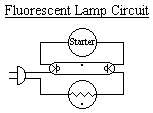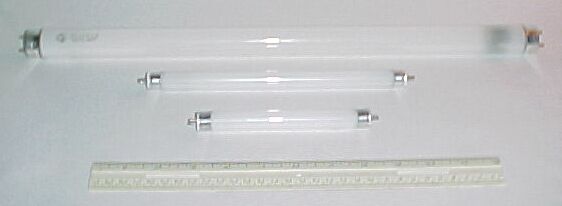


Fluorescent lamps are a source of light which are much more efficient than incandescent bulbs. A 40-watt fluorescent lamp gives off about the same amount of visible light as a 150-watt incandescent bulb. They also do not tent to get very hot.
A fluorescent lamp is composed of a glass tube with a phosphor coating, and an electrode at each end of the tube. Each electrode has a filament used in starting the lamp. Inside the tube is low pressure argon with a small amount of mercury vapor.

To operate the lamp, a starter and ballast are needed (shown above). When first turning on the lamp, the starter puts the filaments in series and heats them up to supply thermionic emission. The starter then connects the electrodes to the power supply through the ballast. The ballast limits the current through the tube. The arc produced in the tube excites the mercury and argon atoms, producing many frequencies of light, one of them being ultraviolet. But when the light strikes the phosphor coating, it is all changed into visible light. Depending on the phosphor used, warmer and cooler colors can be made.
One type of starter commonly used is called a glow starter. They are composed of a bimetal strip, acting as one contact, and another contact close to the strip (they are normally apart). They are enclosed in a glass tube filled with low pressure argon or neon. When the circuit is first turned on, an arc between the two contacts heats up the bimetal strip, and causes it to bend and make a connection with the other contact. This puts the two filaments in the lamp in series. Once the bimetal strip cools down, it disconnects with the contact, and puts the lamp into operation. If the lamp starts, the current will be flowing through the lamp, and the voltage across the starter will be too low to create a discharge across the contacts, so it will remain inactive. The reason it is called a glow starter is because of the discharge it produces.

A few fluorescent lamps are shown above. They come in many sizes, and much larger ones than shown above. The ruler shown in the bottom of the picture is 12 inches (30.5 centimeters) long.